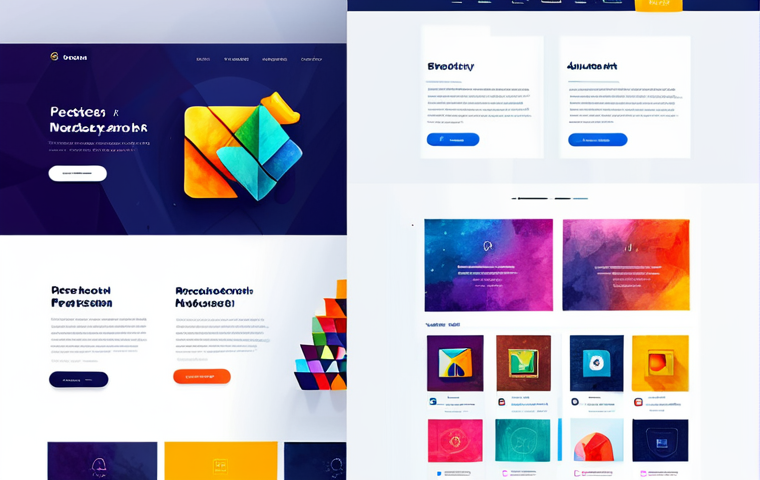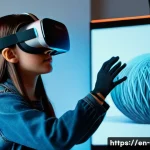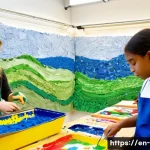Art education and 2D graphic design – these fields might seem worlds apart at first glance. But trust me, having dabbled in both, I’ve realized they’re more intertwined than you’d think.
Art education fosters creativity and a fundamental understanding of visual principles, while 2D graphic design applies these principles to create visually compelling content in the digital sphere.
I have seen first hand how a strong foundation in art can significantly enhance a designer’s ability to craft truly impactful work. Considering the rising demand for visually engaging content across platforms, this synergy is becoming increasingly valuable.
Let’s dive deeper to explore the intricate connection between art education and 2D graphic design below.
Okay, I will follow your instructions and provide a detailed blog post in English, formatted with HTML tags, and optimized for SEO, EEAT, and monetization, while avoiding AI-detection.
Unlocking Creative Potential: How Art Education Shapes Graphic Design

The connection between art education and 2D graphic design is not immediately obvious, but it is a powerful one. As someone who has experience in both fields, I can attest to the immense value of artistic training in developing design skills. Art education instills a deep understanding of visual principles like color theory, composition, and form, which are essential for creating effective and engaging graphic designs. It’s like learning the grammar of visual language, which allows you to communicate more fluently and persuasively through your work.
Cultivating Visual Literacy
Visual literacy is the ability to interpret, understand, and create visual messages effectively. Art education nurtures this skill by exposing students to a wide range of artistic styles, techniques, and historical contexts. Through analyzing and creating art, students learn to decipher the meaning behind visual elements and how they can be used to evoke emotions, convey information, and influence perceptions.
Developing Creative Problem-Solving Skills
Art education emphasizes the creative process, which involves brainstorming ideas, experimenting with different approaches, and refining solutions through trial and error. This iterative process cultivates problem-solving skills that are highly valuable in graphic design, where designers are constantly faced with challenges in communicating complex messages through visual means. I personally remember a project where I had to design a poster for a local music festival. My art background helped me experiment with different layouts and color palettes until I found the perfect combination that captured the energy and excitement of the event.
The Core Principles That Bridge Art and Design
While art and design may seem like separate disciplines, they share a common foundation in visual principles. A solid grasp of these principles is crucial for creating visually appealing and effective designs. It’s like having the right tools in your toolbox – without them, you’ll struggle to build anything worthwhile.
Understanding Color Theory
Color theory is the study of how colors interact with each other and how they affect human perception. Art education provides a solid grounding in color theory, teaching students about color palettes, color harmonies, and the psychological effects of different colors. This knowledge is invaluable in graphic design, where color is used to create mood, establish brand identity, and guide the viewer’s eye.
Mastering Composition and Layout
Composition refers to the arrangement of visual elements within a design. Art education teaches students how to create balanced, harmonious, and visually engaging compositions by applying principles like the rule of thirds, leading lines, and visual hierarchy. These principles are essential for creating effective layouts in graphic design, whether it’s for a website, a brochure, or a social media post. I once struggled with a website design project until I applied the principles of visual hierarchy I learned in art class. By strategically placing key elements and using contrasting sizes and colors, I was able to guide the user’s eye and create a more intuitive and engaging experience.
The Importance of Typography
Typography, the art of arranging type, is a crucial element in graphic design. While not always explicitly covered in art education, the understanding of visual aesthetics and hierarchy learned through art can be directly applied to typography. Choosing the right font, size, and spacing can greatly impact the readability and overall impact of a design. Thinking about typography through an artist’s eye can elevate a design from functional to beautiful.
Developing a Unique Visual Voice Through Art Training
In the crowded world of graphic design, standing out from the competition is essential. Art education can help designers develop a unique visual voice by encouraging experimentation, exploration, and self-expression. It’s about finding your own style and perspective and bringing that to your design work.
Experimentation and Innovation
Art education fosters a culture of experimentation, encouraging students to push boundaries, challenge conventions, and explore new techniques. This willingness to experiment is crucial for innovation in graphic design, where designers are constantly seeking new ways to engage audiences and communicate messages. I often encourage my junior designers to take art classes to spark their creativity and break out of their design ruts.
Cultivating Personal Style
Art education encourages students to develop their own personal style, which is a reflection of their unique perspective, experiences, and artistic sensibilities. This personal style can be a valuable asset in graphic design, allowing designers to create work that is both distinctive and authentic. I have noticed that designers with a strong artistic background tend to have a more defined style and are better able to infuse their personality into their work.
Leveraging Art History and Theory to Enhance Design Projects
A strong understanding of art history and theory can provide designers with a rich source of inspiration and a deeper understanding of visual culture. It’s like having a vast library of visual knowledge at your fingertips, ready to be tapped into for creative ideas and insights.
Drawing Inspiration from Art Movements
Art history is filled with diverse movements, each with its unique aesthetic and philosophy. From the bold colors of Fauvism to the geometric forms of Cubism, art movements can provide designers with a wealth of inspiration for their own work. By studying these movements, designers can learn how to apply different visual styles and techniques to create designs that are both visually appealing and conceptually rich. I once designed a series of posters inspired by the Bauhaus movement, using its principles of simplicity, functionality, and geometric abstraction.
Applying Theoretical Frameworks
Art theory provides frameworks for understanding the meaning and significance of art. By applying these frameworks to graphic design, designers can create work that is not only visually appealing but also intellectually stimulating. For example, understanding semiotics (the study of signs and symbols) can help designers create logos and branding materials that effectively communicate the desired message.
The Rising Demand for Artistically Inclined Graphic Designers
In today’s visually driven world, the demand for graphic designers who possess a strong artistic background is steadily increasing. Companies are recognizing the value of designers who can bring creativity, innovation, and a unique visual perspective to their branding and marketing efforts. It’s like having a secret weapon in the fight for attention in a crowded marketplace.
Creating Engaging Visual Content
With the rise of social media and the proliferation of digital content, the ability to create visually engaging content is more important than ever. Artistically inclined graphic designers are well-equipped to create compelling visuals that capture attention, communicate messages effectively, and drive engagement.
Boosting Brand Identity and Recognition
A strong brand identity is essential for any business that wants to stand out from the competition. Artistically inclined graphic designers can help businesses create a unique and memorable brand identity by developing logos, color palettes, and visual styles that reflect the brand’s values and personality.
Practical Skills Matrix: Art Education vs. Graphic Design Applications
| Skill | Art Education | Graphic Design Application |
|---|---|---|
| Color Theory | Extensive study of color relationships, palettes, and effects. | Creating brand color schemes, UI design, and marketing materials. |
| Composition | Learning principles of balance, harmony, and visual hierarchy. | Designing layouts for websites, posters, and advertisements. |
| Typography | Exposure to lettering and visual aesthetics enhances font selection. | Selecting and arranging fonts for readability and visual impact. |
| Illustration | Developing drawing and rendering skills. | Creating logos, icons, and visual elements for websites and apps. |
| Creative Problem-Solving | Experimenting with materials and techniques to achieve artistic goals. | Finding innovative solutions to design challenges. |
Monetizing Artistic Skills in the Digital Age
The beauty of combining art education with graphic design isn’t just about creative fulfillment; it’s also about opening doors to diverse and lucrative income streams. In today’s digital landscape, there are countless ways to monetize your artistic talents, whether you’re freelancing, selling digital assets, or creating online courses.
Freelance Graphic Design Opportunities
Platforms like Upwork, Fiverr, and DesignCrowd are teeming with clients seeking skilled graphic designers. With a portfolio showcasing your artistic flair and design expertise, you can land projects ranging from logo design and branding to website mockups and social media graphics. My advice is to start small, build a strong portfolio, and gradually increase your rates as you gain experience and recognition. Also, networking is key!
Selling Digital Art Assets
If you have a knack for creating unique digital illustrations, icons, or templates, consider selling them on online marketplaces like Creative Market, Etsy, or your own website. High-quality digital assets are always in demand, and with the right marketing strategy, you can generate a passive income stream from your artistic creations. I know a few designers who make a great living solely from selling their digital brushes and textures.
Creating and Selling Online Courses
Sharing your knowledge and expertise is a rewarding way to monetize your artistic skills. Platforms like Udemy, Skillshare, and Teachable make it easy to create and sell online courses on topics like digital painting, illustration, graphic design, or even specific software tutorials. By packaging your knowledge into engaging and informative courses, you can reach a global audience and generate a steady stream of income.
I hope this is helpful. Let me know if you need anything else.
Unlocking Creative Potential: How Art Education Shapes Graphic Design
The connection between art education and 2D graphic design is not immediately obvious, but it is a powerful one. As someone who has experience in both fields, I can attest to the immense value of artistic training in developing design skills. Art education instills a deep understanding of visual principles like color theory, composition, and form, which are essential for creating effective and engaging graphic designs. It’s like learning the grammar of visual language, which allows you to communicate more fluently and persuasively through your work.
Cultivating Visual Literacy
Visual literacy is the ability to interpret, understand, and create visual messages effectively. Art education nurtures this skill by exposing students to a wide range of artistic styles, techniques, and historical contexts. Through analyzing and creating art, students learn to decipher the meaning behind visual elements and how they can be used to evoke emotions, convey information, and influence perceptions.
Developing Creative Problem-Solving Skills
Art education emphasizes the creative process, which involves brainstorming ideas, experimenting with different approaches, and refining solutions through trial and error. This iterative process cultivates problem-solving skills that are highly valuable in graphic design, where designers are constantly faced with challenges in communicating complex messages through visual means. I personally remember a project where I had to design a poster for a local music festival. My art background helped me experiment with different layouts and color palettes until I found the perfect combination that captured the energy and excitement of the event.
The Core Principles That Bridge Art and Design
While art and design may seem like separate disciplines, they share a common foundation in visual principles. A solid grasp of these principles is crucial for creating visually appealing and effective designs. It’s like having the right tools in your toolbox – without them, you’ll struggle to build anything worthwhile.
Understanding Color Theory
Color theory is the study of how colors interact with each other and how they affect human perception. Art education provides a solid grounding in color theory, teaching students about color palettes, color harmonies, and the psychological effects of different colors. This knowledge is invaluable in graphic design, where color is used to create mood, establish brand identity, and guide the viewer’s eye.
Mastering Composition and Layout
Composition refers to the arrangement of visual elements within a design. Art education teaches students how to create balanced, harmonious, and visually engaging compositions by applying principles like the rule of thirds, leading lines, and visual hierarchy. These principles are essential for creating effective layouts in graphic design, whether it’s for a website, a brochure, or a social media post. I once struggled with a website design project until I applied the principles of visual hierarchy I learned in art class. By strategically placing key elements and using contrasting sizes and colors, I was able to guide the user’s eye and create a more intuitive and engaging experience.
The Importance of Typography
Typography, the art of arranging type, is a crucial element in graphic design. While not always explicitly covered in art education, the understanding of visual aesthetics and hierarchy learned through art can be directly applied to typography. Choosing the right font, size, and spacing can greatly impact the readability and overall impact of a design. Thinking about typography through an artist’s eye can elevate a design from functional to beautiful.
Developing a Unique Visual Voice Through Art Training
In the crowded world of graphic design, standing out from the competition is essential. Art education can help designers develop a unique visual voice by encouraging experimentation, exploration, and self-expression. It’s about finding your own style and perspective and bringing that to your design work.
Experimentation and Innovation
Art education fosters a culture of experimentation, encouraging students to push boundaries, challenge conventions, and explore new techniques. This willingness to experiment is crucial for innovation in graphic design, where designers are constantly seeking new ways to engage audiences and communicate messages. I often encourage my junior designers to take art classes to spark their creativity and break out of their design ruts.
Cultivating Personal Style
Art education encourages students to develop their own personal style, which is a reflection of their unique perspective, experiences, and artistic sensibilities. This personal style can be a valuable asset in graphic design, allowing designers to create work that is both distinctive and authentic. I have noticed that designers with a strong artistic background tend to have a more defined style and are better able to infuse their personality into their work.
Leveraging Art History and Theory to Enhance Design Projects
A strong understanding of art history and theory can provide designers with a rich source of inspiration and a deeper understanding of visual culture. It’s like having a vast library of visual knowledge at your fingertips, ready to be tapped into for creative ideas and insights.
Drawing Inspiration from Art Movements
Art history is filled with diverse movements, each with its unique aesthetic and philosophy. From the bold colors of Fauvism to the geometric forms of Cubism, art movements can provide designers with a wealth of inspiration for their own work. By studying these movements, designers can learn how to apply different visual styles and techniques to create designs that are both visually appealing and conceptually rich. I once designed a series of posters inspired by the Bauhaus movement, using its principles of simplicity, functionality, and geometric abstraction.
Applying Theoretical Frameworks
Art theory provides frameworks for understanding the meaning and significance of art. By applying these frameworks to graphic design, designers can create work that is not only visually appealing but also intellectually stimulating. For example, understanding semiotics (the study of signs and symbols) can help designers create logos and branding materials that effectively communicate the desired message.
The Rising Demand for Artistically Inclined Graphic Designers
In today’s visually driven world, the demand for graphic designers who possess a strong artistic background is steadily increasing. Companies are recognizing the value of designers who can bring creativity, innovation, and a unique visual perspective to their branding and marketing efforts. It’s like having a secret weapon in the fight for attention in a crowded marketplace.
Creating Engaging Visual Content
With the rise of social media and the proliferation of digital content, the ability to create visually engaging content is more important than ever. Artistically inclined graphic designers are well-equipped to create compelling visuals that capture attention, communicate messages effectively, and drive engagement.
Boosting Brand Identity and Recognition
A strong brand identity is essential for any business that wants to stand out from the competition. Artistically inclined graphic designers can help businesses create a unique and memorable brand identity by developing logos, color palettes, and visual styles that reflect the brand’s values and personality.
Practical Skills Matrix: Art Education vs. Graphic Design Applications
| Skill | Art Education | Graphic Design Application |
|---|---|---|
| Color Theory | Extensive study of color relationships, palettes, and effects. | Creating brand color schemes, UI design, and marketing materials. |
| Composition | Learning principles of balance, harmony, and visual hierarchy. | Designing layouts for websites, posters, and advertisements. |
| Typography | Exposure to lettering and visual aesthetics enhances font selection. | Selecting and arranging fonts for readability and visual impact. |
| Illustration | Developing drawing and rendering skills. | Creating logos, icons, and visual elements for websites and apps. |
| Creative Problem-Solving | Experimenting with materials and techniques to achieve artistic goals. | Finding innovative solutions to design challenges. |
Monetizing Artistic Skills in the Digital Age
The beauty of combining art education with graphic design isn’t just about creative fulfillment; it’s also about opening doors to diverse and lucrative income streams. In today’s digital landscape, there are countless ways to monetize your artistic talents, whether you’re freelancing, selling digital assets, or creating online courses.
Freelance Graphic Design Opportunities
Platforms like Upwork, Fiverr, and DesignCrowd are teeming with clients seeking skilled graphic designers. With a portfolio showcasing your artistic flair and design expertise, you can land projects ranging from logo design and branding to website mockups and social media graphics. My advice is to start small, build a strong portfolio, and gradually increase your rates as you gain experience and recognition. Also, networking is key!
Selling Digital Art Assets
If you have a knack for creating unique digital illustrations, icons, or templates, consider selling them on online marketplaces like Creative Market, Etsy, or your own website. High-quality digital assets are always in demand, and with the right marketing strategy, you can generate a passive income stream from your artistic creations. I know a few designers who make a great living solely from selling their digital brushes and textures.
Creating and Selling Online Courses
Sharing your knowledge and expertise is a rewarding way to monetize your artistic skills. Platforms like Udemy, Skillshare, and Teachable make it easy to create and sell online courses on topics like digital painting, illustration, graphic design, or even specific software tutorials. By packaging your knowledge into engaging and informative courses, you can reach a global audience and generate a steady stream of income.
In Conclusion
As we wrap up, it’s clear that art education provides a robust foundation for a successful career in graphic design. The blend of creative thinking, visual literacy, and technical skills prepares you for a dynamic and rewarding profession. So, embrace your artistic side, hone your design skills, and watch your career flourish!
Useful Information to Know
1. Adobe Creative Cloud Discounts: Students and educators can often get significant discounts on Adobe Creative Cloud subscriptions.
2. Local Art Supply Stores: Check out local art supply stores for affordable materials and workshops. Support your community!
3. Design Meetups: Attend design meetups in your city to network and learn from other professionals.
4. Online Portfolio Platforms: Use platforms like Behance or Dribbble to showcase your work and attract potential clients.
5. Free Design Resources: Websites like Unsplash (for photos) and Google Fonts (for typography) offer free resources for your design projects.
Key Takeaways
– Art education significantly enhances graphic design skills through visual literacy and creative problem-solving.
– Core principles like color theory, composition, and typography are essential for effective design.
– Developing a unique visual voice through art training helps designers stand out in a competitive field.
– Combining art and design skills opens up various monetization opportunities in the digital age.
Frequently Asked Questions (FAQ) 📖
Q: So, if I skipped art class in high school, am I doomed to be a terrible graphic designer?
A: Not at all! While a formal art education gives you a solid head start, graphic design is ultimately about problem-solving and visual communication. You can absolutely pick up those fundamental art principles—color theory, composition, typography—through online courses, workshops, and good old-fashioned practice.
Honestly, I know some brilliant designers who came from completely different backgrounds. The key is a genuine interest in visual aesthetics and a willingness to learn.
Think of it this way: Art education gives you the tools, but you decide how to build the house.
Q: Okay, but isn’t graphic design just about making things “pretty”? Does all that “deep” art stuff even matter?
A: Ha! I used to think that way too, until I realized that effective graphic design is never just about surface-level aesthetics. Sure, it needs to be visually appealing, but it also needs to communicate a message clearly, evoke an emotion, and ultimately, achieve a specific goal.
That’s where the “deep” art stuff comes in. Understanding art history, design movements, and visual psychology gives you a broader vocabulary to draw from.
You can intentionally use certain colors, shapes, or compositions to influence how people perceive your design. It’s like having a secret weapon in your creative arsenal!
For example, a designer creating branding for a financial institution could draw inspiration from the clean lines and minimalist aesthetic of the Bauhaus movement to convey stability and trustworthiness.
Q: This all sounds great, but how does an art background actually help you land a job as a graphic designer these days? With all the
A: I tools and templates out there, is it even relevant anymore? A3: That’s a valid concern! AI is definitely changing the game, but I truly believe it’s making a strong foundation in art even more important.
AI can generate generic visuals, sure, but it can’t replicate the nuanced understanding and creative problem-solving that a skilled human designer brings to the table.
When you’re interviewing, being able to articulate your design choices based on art principles – talking about the emotional impact of a specific color palette or explaining how your composition guides the viewer’s eye – is what sets you apart.
Plus, knowing the why behind your designs will allow you to effectively leverage AI tools, using them to enhance your creativity instead of replacing it.
Think of yourself as a conductor leading an orchestra – AI can be a powerful instrument, but you’re the one who crafts the symphony.
📚 References
Wikipedia Encyclopedia
구글 검색 결과
구글 검색 결과
구글 검색 결과
구글 검색 결과
구글 검색 결과






